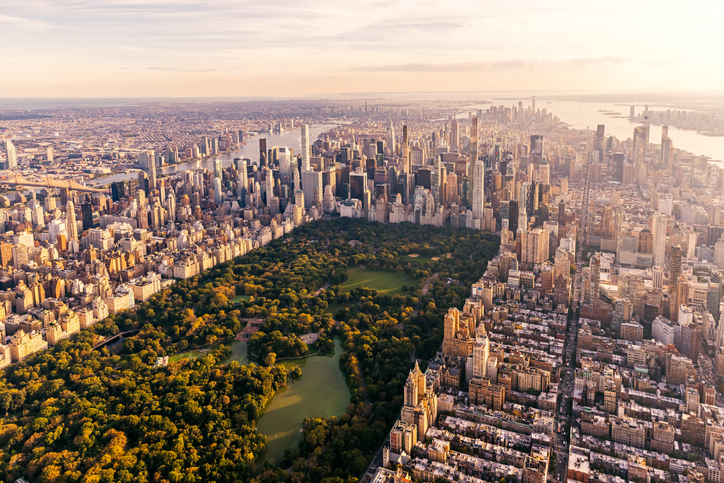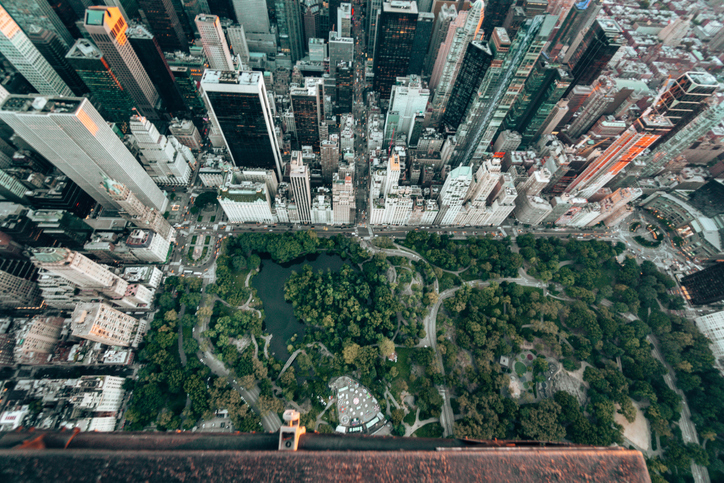
Source: Alexander Spatari / Getty
Central Park, in New York City, is one of the most famous parks in the world. Its iconic skylines and beautiful scenery get visited by over 25 million people each year. It’s adored by both the locals and tourists from all over the world.
But the park has a history shrouded in black American folklore. Stories that we know to be partly true, but important details lost in the building of a nation.
Decades before Central Park’s existence, a small part of the land was known as Seneca Village, a self-sufficient, middle-class African-American and Irish community founded in 1825 by members of The New York African Society for Mutual Relief. The group was led by abolitionist William Hamilton, an alleged bi-racial illegitimate son of one of America’s founding fathers, Alexander Hamilton.
Alexander Hamilton And His Alleged Black Illegitimate Son
Many of us have been reacquainted with the historical statesman and politician through the popular Broadway play Hamilton. His history is fascinating, but 200 years have passed which makes it difficult for historians to find Hamilton’s secrets. But history does leave clues, and although these clues aren’t finite, connecting their dots makes for intriguing stories. One thing is for sure, Hamilton had a thing for the ladies.
He arrived on the shores of New York City in 1772. Some believe he became enamored with a free black woman and they had a son in 1773 named William Alexander. Historians haven’t found any documents to prove Alexander was William’s father, but folklore prevailed.
William Hamilton’s Humble Beginnings
William, born a free black, learned to become a carpenter and made a decent living. But, like his alleged father, he would get involved in community activism. Although the North wasn’t known for slavery, it benefited from it tremendously. Dutch and English merchants built the majority of the city’s local economy around shipping slaves and what they produced.
Some historians believe almost every profitable businessman in New York during the 18th century had a stake in slavery. In 1817 New York passed a law that would free slaves born before 1799 but not until 1827.
Although free, blacks were relegated to live in poor areas of the city like the infamous Five Points. It was a disease-ridden, crime-infested way of life. Something many blacks wished to escape. But if you didn’t own any land, there was no way to get from under the thumb of oppression unless you owned land.
Whites who farmed and owned land north of Manhattan weren’t keen on selling land to black folks. The Five Points was also becoming unsafe for many free blacks. Irish immigrants began to fight for their rights and some of them blamed emancipated blacks for their unemployment and housing plights.
18th century Blacks in New York needed a safe place to live and William Hamilton would eventually try to give them one.
The New York African Society for Mutual Relief (1808)
In 1808 Hamilton would co-found the New York African Society for Mutual Relief. The society was created to assist black widows and orphans, pay for its member’s burial expenses, and buy real estate. Hamilton would be their first president, but all of their founding members were prominent black men who supported the advancement of black people in New York City. Their members were made up of real estate dealers, a mechanic, bookmakers, former slaves, and orators who support abolition.
Hamilton would also help found the African Methodist Episcopal Zion Church, created for blacks who didn’t want to practice under the prejudices found in many white churches at the time.
The Black Town Of Seneca Village (1825)
In 1825, society saw an opportunity to build something for black people in the city of New York. White landowners near West 82nd to West 89th Street were looking to sell some of their lands. But unlike most of their white counterparts, John and Elizabeth Whitehead were willing to sell to blacks.
They subdivided their land, selling the first 15 lots to Epiphany Davis and Andrew Williams, two well-known members of The New York African Society for Mutual Relief. Soon after the AME Zion Church would purchase six more lots. By 1832, the Whiteheads has sold half their land to free blacks and there were 10 homes in the small community called Seneca Village. Residents here built gardens, raised livestock, and fished from the Hudson River as a source of food. They even used a nearby spring for fresh drinking water. The community seemed to escape from the housing discrimination plights of downtown Manhattan and this attracted more black families looking for a better life. Its location created a refuge from discrimination black were feeling all over America.
By the 1850s Seneca Village had grown into a 50 home community with three churches, an all-black school, and a cemetery. Owning property was unique to black people during the time, but in Seneca Village it was common. By 1855, half of the black people living in the village owned their homes. If you were black at the time in order to vote you had to own $250 worth of property and hold residency there for at least three years. In 1845 there were 100 black men in the state who were eligible to vote, 10 of them lived in Seneca Village.
But like so many stories from black American history this one too ends in tragedy.
The Building Of Central Park (1857)

Source: franckreporter / Getty
In 1853, New York State would create a law that set aside 775 acres of land in Manhattan to build the county’s first-ever public park. The plans were to use plots of land from 59th to 106th streets between Fifth and Eighth Ave. The law allowed the city to seize any owned land through eminent domain, this included all of Seneca Village. Black families and Irish families who had built lives for themselves were forced to vacate their homes by 1857. Some villages tried to fight the government, filing lawsuits in hopes of keeping their homes. Every lawsuit was rejected by the courts and landowners were paid on average $700 per lot.
After Central Park’s completion in 1858, there was nothing left of Seneca Village. Its legacy, its people, and its memories; all ghosts. Now all that remains is a small plaque that recognizes its existence. Seneca Village was able to accomplish so much in just 32 years; imagine if it was truly given a chance to flourish.
And although we might never know the truth behind the origins of William Hamilton or Seneca Village, we know that black people are just as much a part of this country’s history as anyone else. So if history won’t tell our stories, let folklore do it.
SEE ALSO:
The Antebellum Tale Of Black Slave Girl Molly And The Haunting Of Sorrel-Weed House
The Haunting Of Lake Lanier And The Black City Buried Underneath
[ione_media_gallery id=”3039818″ overlay=”true”]
